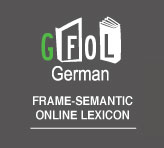What is the G-FOL?
An online learner's dictionary of German for English speakers! But not like any you've seen before. This one is meant for learners of German, and is based on cutting edge linguistic theory and research, which means that we're leveraging what we know about language and the brain to help you learn how to use the German language like native speakers do.
The German Frame-semantic Online Lexicon (G-FOL) is based on the theory of Frame Semantics and draws on linguistic data from the real world in order to create entries about German words and expressions that are readable, easy to understand and above all USEFUL for learners. We include information about meaning, use (including grammar), differences between German and English, dialectal differences, cultural practices, and social norms - on top of all the things you'd find in any other German dictionary. G-FOL is a part of the German FrameNet project, which was founded in 2005 at the University of Texas at Austin.
What is Frame Semantics? What's a frame?
Frame Semantics is what makes this pedagogical dictionary stand apart from other bilingual dictionaries. It's a theory developed by Professor Charles Fillmore at the University of California, Berkeley, who realized that in order to understand and model the way humans use language, we need a way to understand and model the way concepts that underlie language are structured. This is where frames come in.
Frames are a tool for modelling concepts; you can think of them as scenarios or templates for kinds of experiences/things you might encounter in the world. The Sleep frame is an example everyone will be familiar with; to understand the lexical unit* "to sleep" (or "schlafen"), you must know that humans and animals periodically lose consciousness for a time, and then regain it (you also know that this is normal and nothing to be alarmed about; real world knowledge plays an important role in how you interpret lexical units that evoke the frame). The process in this frame involves a Sleeper who typically falls asleep, sleeps, wakes up and eventually gets up. Participants in the frame, like the Sleeper, are referred to as Frame Elements, because they make up the structure of the frame. These are important because different patterns of use (e.g. case, prepositions, etc.) are associated with different Frame Elements. Knowing this helps you know when to use which forms. If you visit the Sleep frame, you'll notice there are all kinds of other lexical units related to sleeping, like "der Alptraum" ("nightmare"), "die Schlummertaste" ("snooze button") and "in Ohnmacht fallen" ("to faint"). All of these evoke the Sleep frame because you must understand it in order to understand what they refer to.
*lexical unit: a word/expression in one of its senses
Background on Frame Semantics
Based on Fillmore's work, linguists at the International Computer Science Institute in Berkeley developed an English database called FrameNet, which contains a multitude of authentic corpus data that they used to create frames. Sentences containing relevant lexical units (LUs) were analyzed to create the frames (so this approach is based on empirical data), then the sentences were annotated with frame elements (FEs). The different ways FEs are realized are listed along with all the annotated example sentences in the FrameNet database, making it an extremely useful tool for linguistic research and computation, as it is both human and machine readable. FrameNet is now a dictionary of more than 10,000 word senses, most of them with annotated examples that show the meaning and usage. Researchers have even taken the results from the Berkeley FrameNet for English and applied them to other languages, resulting in FrameNets for Spanish, Swedish, German, Portuguese, Japanese, and other languages, including the German FrameNet at The University of Texas at Austin.
Unfortunately for students, FrameNet (and German FrameNet, etc.) is too technical and complex for the average casual learner or college student; the G-FOL was established to bring learners of German the same kinds of valuable information that is in FrameNet: frames, their frame elements and lexical units, patterns of how FEs are realized, and relations between words. In addition, the G-FOL saw the need for explicit explanations of cross-linguistic differences in meaning and use. This kind of vocabulary resource is one of a kind, and we hope it can serve as a prototype for other languages in the future.
We'd appreciate your feedback
The G-FOL is meant to be a user friendly resource for students to learn about the meanings of words/expressions (semantics), the grammar associated with them (syntax) and the cultural and social factors relevant to their use (pragmatics). So, please take a look at G-FOL and let us know if we achieved our goal. Does G-FOL help you learn German? Do you use it to study? Or would you like to use it in a German class you're teaching? Explore the site and learning materials we have, then help us make this a better tool for you by emailing us your feedback.
Watch this video for examples of why traditional dictionaries aren't enough when it comes to learning vocabulary:
This video illustrates why a frame-based approach to language - one that includes both meaning of lexical units and how to use them - can help speakers avoid misunderstandings:
Ready for an overview? This video explains what kinds of information the G-FOL has to offer and how to navigate the website:
The contents of this website were developed under grant #P229A100014 from the U.S. Department of Education. However, those contents to not necessarily represent the policy of the U.S. Department of Education, and you should not assume endorsement by the Federal Government.
